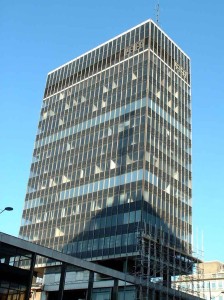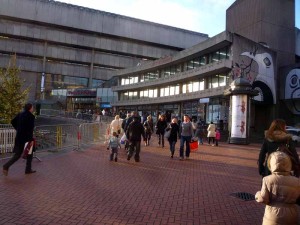Alan Clawley writes on the legacy left by Birmingham architect John Madin who died this month.
Many of the tributes paid to John Madin suggest that his passing marks the end of an era. In one sense that is true – he is one of the few remaining architects of a generation whose attitudes were influenced by the Second World War and who had the chance to sweep away the past using the tools of Modernism to construct a new world.
But it is too simple to allow Madin’s passing to close the book on that period and to condemn every modernist building and new town designed by Madin and his idealistic colleagues as mistakes that can only be rectified by today’s generation of architects, town planners and civic leaders.
The fate of Madin’s buildings was not always determined simply by changing architectural fashion. Swathes of his residential work still exist in Edgbaston, Telford, Corby, and abroad, and are admired and lived in today. But Madin has suffered major casualties. For him, the demolition of a building was comparable to the death of a child. That was a measure of how much care he took to design his buildings.
The Post and Mail building was no doubt praised as ‘state-of-the-art’ when it was opened in 1960. It integrated all the diverse processes of publishing a daily and evening newspaper in one building. But before long, hot metal letterpress was replaced by digital technology, and all the newspapers started decamping from their expensive city centre offices to anonymous industrial estates.
Pebble Mill was truly pioneering when it was opened by Princess Ann in 1971 but a mere three decades later, the BBC declared it was no longer needed by that rapidly down-sizing and out-sourcing organisation.
The Central Library, opened by Labour’s Harold ‘White Heat of Technology’ Wilson in 1974, is a different case. The threat of its early demise in 2013 roused its admirers to mount a spirited defence against official claims, first surfacing in 2002, that it was ‘crumbling’, ‘not fit for purpose’, had been rendered obsolete by information technology and was too ugly to live. I was shocked that the council could even consider destroying such a fine solid structure. My children grew up with it. We all took it for granted. I was vaguely aware at the time that its architect, John Madin, was Birmingham’s premier modern architect, but my curiosity drove me to find out what else he had built. This eventually, and unexpectedly for me, led to the writing of a book. It built on Andy Foster’s magnificent Buildings of Birmingham (Pevsner) that came out in 2005.
This is how I came to know John Madin. He came to see the exhibition, ‘Back to the Modern’, that I presented in the Central Library in 2006 to draw attention to its undoubted architectural quality.
The book was published by the Royal Institute of British Architects, and launched in March 2011. John returned to his old home ground of Edgbaston to address a large and excited gathering of friends, family and former colleagues in the Chamber of Commerce building designed by him in 1960. His son, Christopher, had put together an exhibition of archive and recent photographs and later produced an ebook illustrating all of John’s work, including the many buildings that couldn’t feature in the book because of limitations of space.
Right up to the last John would ring me nearly every week for news about the Central Library – except when he was supervising building work at Aberdovey Hillside Park, on a skiing holiday, or sailing in the Med. As his widow and lifelong partner Judith said to me when telling me the sad news, John was an ‘action man’ who found a quiet lifestyle impossible to imagine.




